Full Text Searchable PDF User Manual
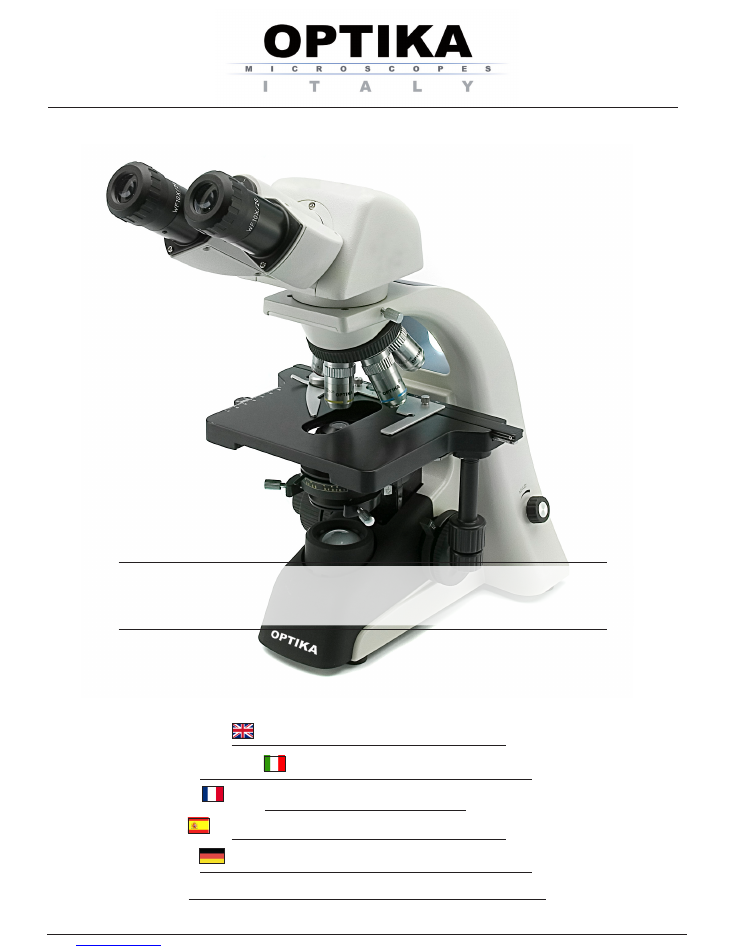
OPTIKA
MICROSCOPES - ITALY
www.optikamicroscopes.com - info@optikamicroscopes.com
Ver. 5.0.0
OPERATION MANUAL
GUIDA UTENTE
MANUEL D’INSTRUCTIONS
B-350
MANUAL DE INSTRUCCIONES
BEDIENUNGSANLEITUNG

Page 2
INDEX
1.0 DESCRIPTION pag.
3
2.0 INTRODUCTION pag.
6
3.0 UNPACKING AND ASSEMBLY
pag.
7
4.0 USING THE MICROSCOPE
pag.
9
4.1 Observation head
4.2 Place the specimen on the stage
4.3 Illumination system settings
4.4 Interpupillary distance
4.5 Focus tension adjustment
4.6 Diopter adjustment
4.7 Condenser
4.8 Numerical aperture setting
4.9 Phase rings centering (models B-352Ph and B353Ph)
4.10 Additional filters
5.0 MAINTENANCE
pag.
12
5.1 Microscopy environment
5.2 Before and after using the microscope
5.3 Precautions for a safe use
5.4 Cleaning the optics
6.0
TECHNICAL
SPECIFICATIONS
pag
13
7.0
RECOVERY
AND
RECYCLING
pag
14
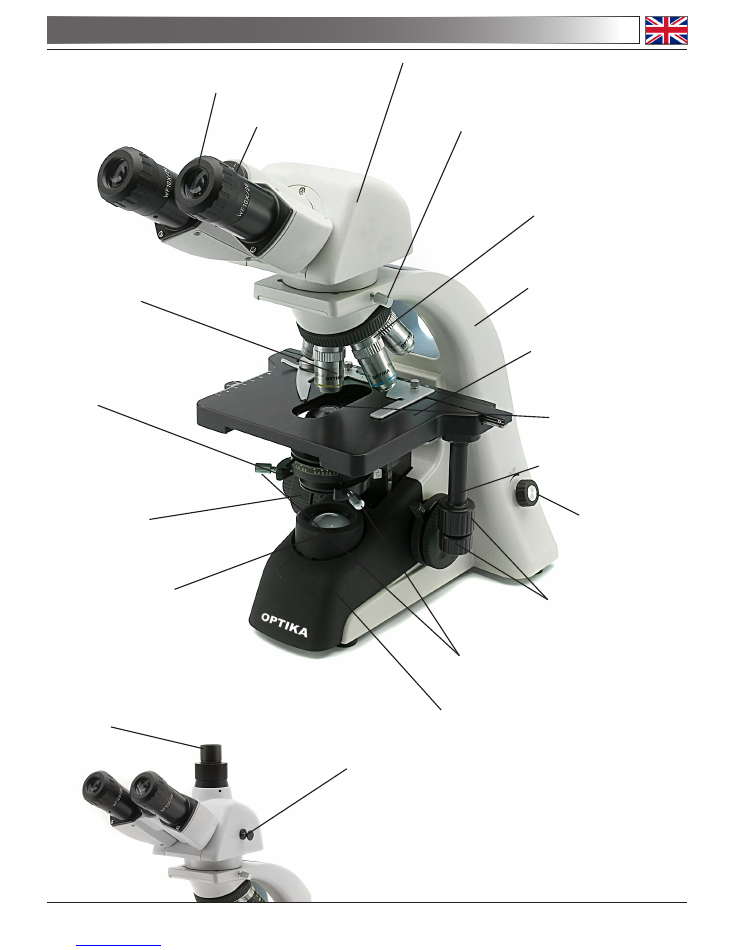
Page 3
1.0 DESCRIPTION
BINOCULAR OBSERVATION
HEAD
HEAD LOCKING
SCREW (1)
REVOLVING NOSEPIECE
STAGE
TRANSLATION KNOBS
MAIN BODY
BRIGHTNESS
ADJUSTMENT
CONDENSER CENTERING
SCREWS (2)
LED
ILLUMINATOR
IRIS DIAPHRAGM
(3)
EYEPIECE
FLIP OUT FILTER
HOLDER
LIGHT PATH
SELECTOR LEVER
PHOTO PORT
CONDENSER
TRINOCULAR OBSERVATION HEAD
FOCUS STOP KNOB
LAMP COVER
OBJECTIVE
INTERPUPILLARY
DISTANCE SCALE
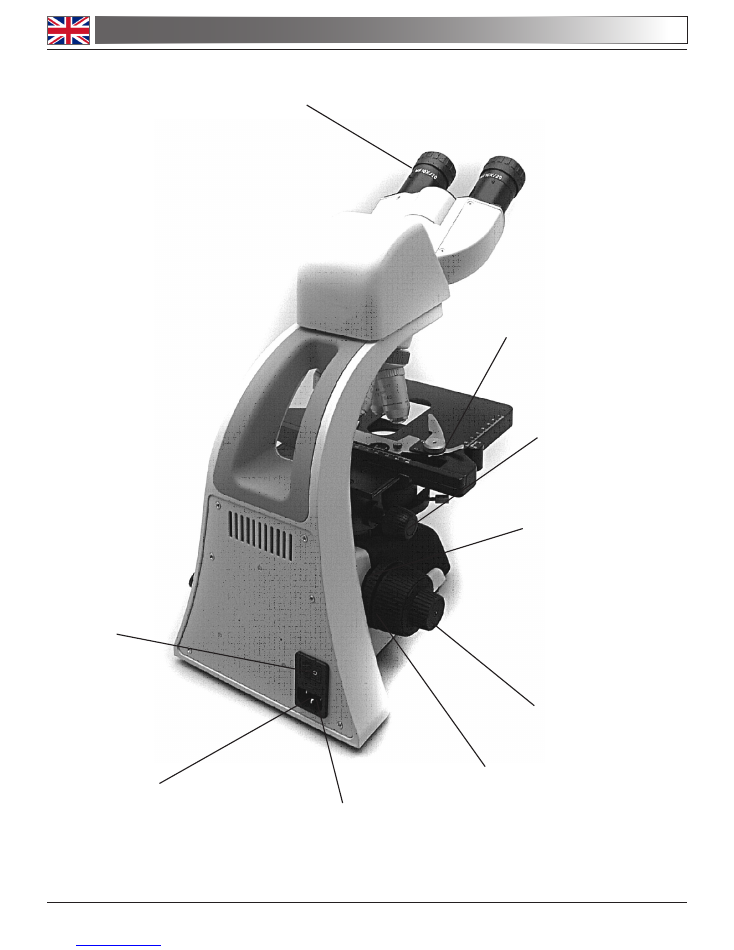
Page 4
SLIDE CLAMP
FINE FOCUSING KNOB
MAINS CABLE
ATTACHMENT
FUSE
DIOPTRIC
ADJUSTMENT RING
ON-OFF SWITCH
CONDENSER HEIGHT
ADJUSTMENT (4)
TENSION
ADJUSTMENT KNOB (5)
COARSE FOCUSING KNOB
1.0 DESCRIPTION
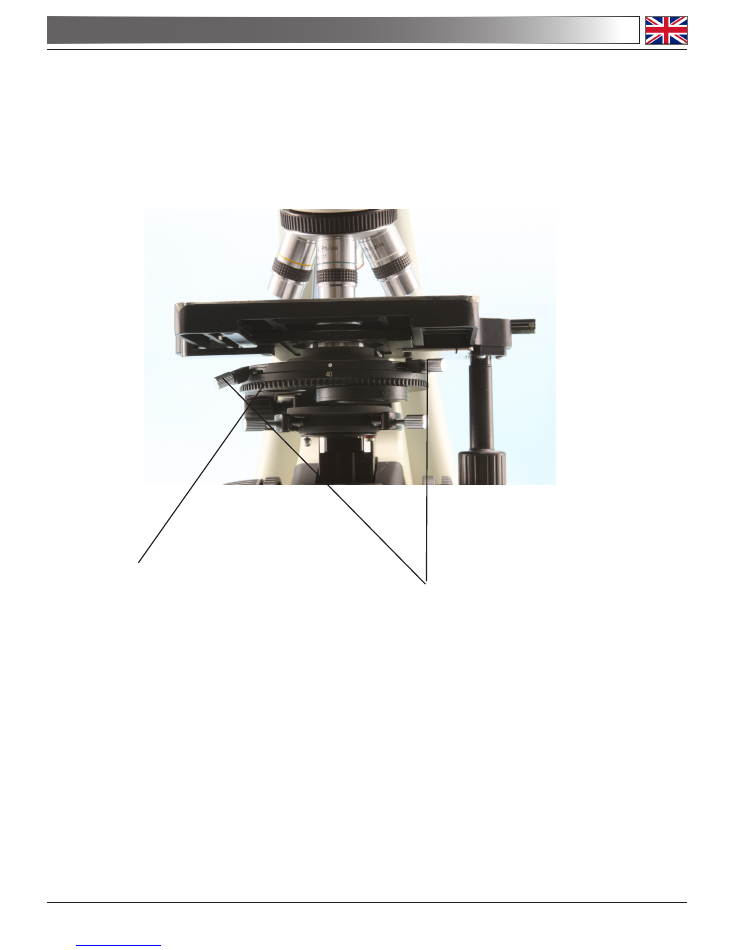
Page 5
CONDENSER
TURRET (6)
PHASE RINGS
CENTERING LEVERS (7)
1.0 DESCRIPTION

Page 6
This microscope is a scientific precision instrument designed to last for many years with a minimum of main
-
tenance. It is built to high optical and mechanical standards and to withstand daily use.
Optika reminds you that this manual contains important information on safety and maintenance, and that it
must therefore be made accessible to the instrument users.
Optika declines any responsibility deriving from instrument uses that do not comply with this ma-nual.
2.1 Safety guidelines
This manual contains important information and warnings regarding safety about installation, use and
maintenance of the microscope B-350. Please read this manual carefully before using the equipment.
To ensure safe use, the user must read and follow all instructions in this manual. OPTIKA products
are designed for safe use in normal operating conditions. The equipment and accessories described
in the manual are manufactured and tested according to industry standards for safety instrumentation
laboratory. Misuse can cause personal injury or damage to the instrument. Keep this manual at hand
close to the instrument, for an easy consultation.
2.2 Electrical safety
Before connecting the power cord to wall outlet, ensure that your mains voltage for your region corre
-
sponds to the voltage supply of the instrument, and that the illuminator’s switch is in position OFF. The
user must observe the safety regulations in force in his region. The instrument is equipped with CE sa
-
fety marking, in any case the user has full responsibility concerning the safe use of that instrument.
2.3 Warning/Caution symbols used in this manual
The user should be aware of safety aspects when using the instrument. Warning or hazard symbols
are shown below. These symbols are used in this manual.
The instructions on this symbol to avoid possible severe personal injuries.
Warning of use; the incorrect operation on the instrument can cause damages
to the person or instrument.
Possibility of electric shock.
Attention: high temperature surfaces. Avoid direct contact.
Technical notes or usage tips.
2.0 INTRODUCTION
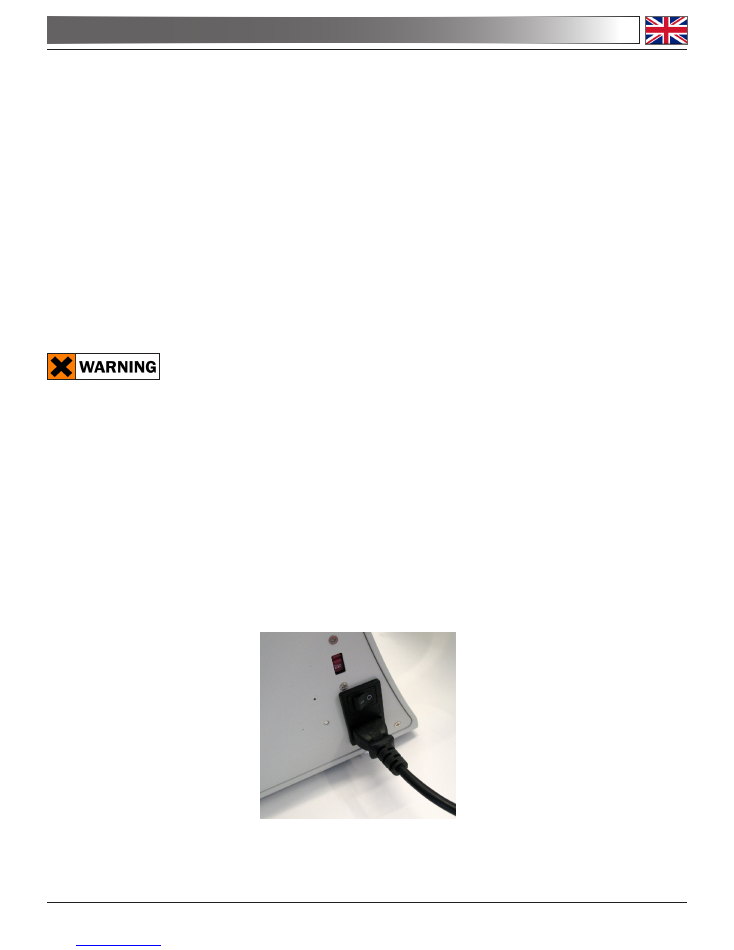
Page 7
3.0 UNPACKING AND ASSEMBLY
The microscope is located in a styrofoam moulded packaging. After removing the adhesive tape from
all packaging, lift the top half of the packaging. Pay attention not to drop or damage the optical com-
ponents (objectives and eyepieces). Extract the microscope from its packaging with both hands (one
around the top arm and one around the base) and place it on a stable surface. Keep it away from
solvents, chemical vapors and excessive moisture. Avoid high temperature environments, the direct
sunshine and excessive vibrations, which could affect the performance of the instrument.
3.1 Operating environment
Temperature: : 10 - 36°C (50 – 96.8°F)
Relative humidity: 0 – 85% up to 30°C (86°F)
3.2 Unpacking microscope
Control the packaging to ensure that all material is present. We recommend that you take note of all
the accessories to facilitate any future orders of spare parts and technical support calls. Make sure
that in the packaging no small accessories or small parts remain. Please keep the original packaging
in a safe place for future transport needs of microscope or accessories.
Never touch the glass surfaces such as lenses or filters. Traces of grease or other residues can redu
-
ce the vision quality of the final image and corrode the surface of lenses in a short time.
3.3 Installing the microscope
Set the optical head on the top arm through the locking screw. Insert the eyepieces into the tubes and
lock them with the small screws which are located to the side of the tubes. Remove the protective film
from the stage of the microscope.
3.4
Connect the mains plug into the socket at the base
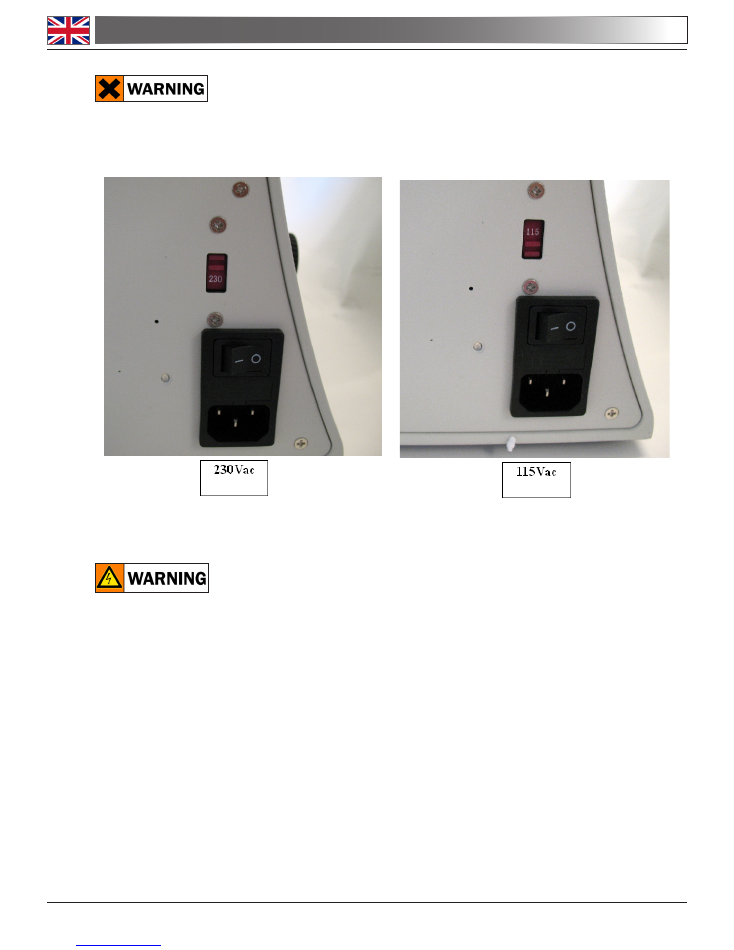
Page 8
Make sure, before you turn the illumination on, that the voltage selector is set to the mains voltage for
your region.
The power cord should be used only on network sockets equipped with adequate grounding.
Contact a technician to check the state of your electrical system.
If there is no need to install additional accessories, the instrument is now ready for use.
3.0 UNPACKING AND ASSEMBLY

Page 9
Once positioned and installed with the necessary components, the microscope is ready to be used.
Your microscope is a laboratory instrument designed to last. Handle it always carefully and avoid
abrupt vibrations or shocks.
Always disconnect the power cable from the microscope when not in use for long time, while you
clean it or when you perform any maintenance.
AVOID DISASSEMBLING THE INSTRUMENT
Do not disassemble the instrument. This entails the cancellation of the warranty and may cause mal
-
function.
4.1 Observation head
Loosen the lock-screw (1), turn the observation head to a comfortable position for observation, and
then lock the lock-screw.
4.2
Place the specimen on the stage
Lock the specimen slide on the mechanical stage using the slide clamp. Ensure that the spe¬cimen is
centred over the stage opening by adjusting the coaxial knobs of the stage.
4.3 Illumination system settings
The microscope is fitted with a white LED illuminator. Before turning on the illumination system, read
the section 5.3 about electrical safety precautions. Insert the plug of the cable into the power socket
and turn on the switch on the back of the main body. Turn the brightness adjustment knob to a bright
-
ness suitable for observation.
4.4 Adjust interpupillary distance
Hold the right and left parts of the observation head with both hands and adjust the interpupil¬lary
distance by turning the two parts until one circle of light can be seen.
The white dot (°) placed on the right eyepiece shows the set interpupillary distance. Just remember
this value to help on later settings.
4.5 Focus tension adjustment
The tension of the coarse focusing knob is preset by factory. To change the tension according to your
preference, just rotate the knob (5) clockwise in order to increase it.
Excessive tension could damage the mechanism of focus. A too loosed tension causes the descent
of the stage by gravity or a sudden loss of focus. In this case, rotate the knob (5) to increase the ten-
sion.
4.0 USING THE MICROSCOPE
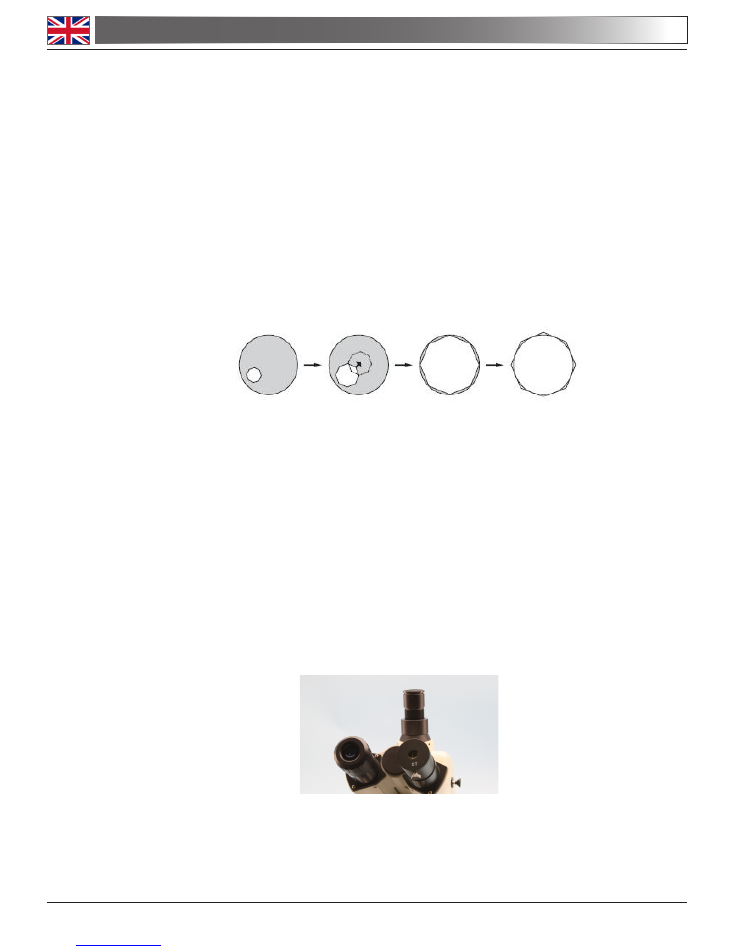
Page 10
4.6 Diopter adjustment
Turn the dioptric adjustment ring on the right eyepiece dioptric up to align the bottom with the gradua
-
ted ring. Turn the coarse focus knob in order to focus the slide with an objective with low magnifica
-
tion. Adjust the fine focus knob until you obtain a clear and defined picture observing with the right
eye, and then repeat the operation with the left dioptric compensation ring and the left eye. When the
image appears in focus, choose the necessary objective with the revolving nosepiece.
4.7 Condenser
Raise or lower the condenser through the knob (4) to obtain a clear and uniform illumination of the
sample.
To center the condenser: completely close the iris diaphragm (3). Using the condenser centering screws
(2), move the diaphragm in the center of the field of view. Then gradually expand the diaphragm until
it is tangent to the edges of the field of view. If necessary, you can perform an additional adjustment.
The condenser is centered when the edges of iris diaphragm are tangent to the field of view.
4.8 Numerical aperture setting
The value of the numerical aperture (N.A.) of the diaphragm is an indication of the contrast of the illu-
mination system. Matching the value of illumination system’s N.A. with that of the objective ensures
the best results in terms of contrast and image quality. To set the numerical aperture of the Illuminator,
adjust the opening of the iris diaphragm (3). In this way you control contrast and image resolution. For
samples with low contrast set the iris to about 75% of the value of the objective’s numerical apertu
-
re.
4.9 Phase rings centering (models B-352Ph and B353Ph)
For models equipped with phase contrast set, you have to perform the centering of the phase rings.
Remove an eyepiece from the head and insert the centering telescope in the empty tube.
4.0 USING THE MICROSCOPE

Page 11
Insert the 10x objective rotating the nosepiece.
Rotate the turret of the condenser (6) until you reach the inscription “10”.
Loosening the lock screw of the centering telescope, focus on the light ring that you observe.
Loosen the locking screws of the phase rings centering levers (7) and slide them forward or backward
until the bright light ring is perfectly aligned with the dark ring.
Repeat for the other objectives (only as a verification of the correct centering).
Once centered with 100x objective, the condenser will be automatically centered also with the other
objectives.
Phase rings will be centered when you see an image like this:
4.10 Additional filters
The blue, yellow and frosted glass filters can be inserted in the flip-out filter holder underneath the
condenser.
4.0 USING THE MICROSCOPE

Page 12
5.1 Microscopy environment
This microscope is recommended to be used in a clean, dry and shock free environment with a tem
-
perature of 0-40°C and a maximum relative humidity of 85 % (non condensing). Use a dehumidifier if
needed.
5.2 Before and after using the microscope
- The microscope should always be kept vertically when moving it and be careful so that no moving
parts, such as the eyepieces, fall out.
- Never mishandle or impose unnecessary force on the microscope.
- Never attempt to service the microscope yourself.
- After use, turn off the light immediately, cover the microscope with the included dust-cover, and keep
it in a dry and clean place.
5.3 Precautions for a safe use
- Before plugging in the power cord with the supply, make sure that the supplying voltage of your region
matches with the operation voltage of the equipment and that the lamp switch is in off-position.
- Do not turn the power on and off, off and on immediately as this will shorten the life span of the bulb
and may cause damage to the electrical system.
- Users should observe all safety regulations of the region. The equipment has acquired the CE safety
label. However, users do have full responsibility to use this equipment safely.
5.4 Cleaning the optics
- If the optical parts need to be cleaned try first to: use compressed air.
- If that is not sufficient: use a soft lint-free piece of cloth with water and a mild detergent.
- And as a final option: use the piece of cloth moistened with a 3:7 mixture of ethanol and ether.
Note: ethanol and ether are highly flammable liquids. Do not use them near a heat source, near
sparks or near electric equipment. Use these chemicals in a well ventilated room.
- Remember to never wipe the surface of any optical items with your hands. Fingerprints can damage
the optics.
- Do not disassemble objectives or eyepieces in attempt to clean them.
If you need to send the microscope to Optika for maintenance, please use the original packaging.
5.0 MAINTENANCE
Description:
Teaching and routine laboratory microscope.
Die-cast metal stand, with great stability and ergonomics, intended for transmitted light
observation.
Illumination:
Light source: X-LED type with white LED; brightness adjustment through a potentiome
-
ter placed in the bottom right side of the stand.
LED power 3W, comparable to 30-35W halogen lamp.
Average LED lifetime about 50.000 hours.
The collecting lens of the illuminator can accommodate additional filters (blue, yellow,
frosted).
Input voltage: 110/230Vac, 50/60Hz, 0,4/0,8A; Fuse: F2A 250V
Maximum power: 7W
Observation
modes:
Brightfield, darkfield, phase contrast, fluorescence
Focus:
Coaxial coarse and fine (graduated, 0.002mm) focusing system, with focusing stop
mechanism (to prevent the objective from hitting the slide).
Focus knobs tension is adjustable.
Stage:
Double layer with mechanical sliding stage, dimensions 160x142mm, mo¬ving ran
-
ge76x52mm. With sample holder for two slides.
Vernier scale with 0.1mm precision on both translation axis.
Nosepiece:
Revolving nosepiece with 4 or 5 positions, with ball-bearing movement.
Head:
Binocular or trinocular, 30° inclined and 360° rotating.
Diopter adjustment on both eyepieces.
Interpupillary adjustment range: 55-75 mm.
Eyepieces:
Wide field eyepieces with 20mm field number.
Objectives:
Achromatic set (160mm tube length):
-) 4X/0.10, 10X/0.25, 40X/0.65, 100X/1.25 (oil immersion)
PlanAchromatic set (160mm tube length):
-) 4X/0.10, 10X/0.25, 40X/0.65, 100X/1.25 (oil immersion)
E-PlanAchromatic IOS set (infinity-corrected, 45mm parfocal distance):
-) 4X/0.10, 10X/0.25, 40X/0.65, 100X/1.25 (oil immersion)
PlanAchromatic Phase Contrast set (160mm tube length):
-) 4X/0.10, 10X/0.25Ph, 40X/0.65Ph, 100X/1.25Ph (oil immersion)
E-PlanAchromatic IOS Phase Contrast set (infinity-corrected, 45mm parfocal distance):
-) 10X/0.25Ph, 20X,0.40Ph, 40X/0.65, 100X/1.25Ph (oil immersion)
PlanAchromatic Darkfield set (160mm tube length):
-) 4X/0.10, 10X/0.25, 40X/0.65, 100X/1.25 with iris (oil immersion)
All optics treated with anti-fungus system.
Condenser:
Abbe condenser, N.A. 1,25 with centering system.
Phase contrast condenser (for 10X, 40X, 100X objectives), brightfield and darkfield.
Phase contrast condenser (for 10X, 20X, 40X, 100X objectives) and brightfield.
Darkfield condenser for oil immersion, N.A. 1,36 with built-in X-LED.
Dimensions:
HEIGHT: 445 mm ( without attachment) / 520 mm (with attachment).
WIDTH: 205 mm
DEPTH: 375 mm
WEIGHT: 4 Kg
Accessories:
User manual and dust cover included.

Page 13
6.0 TECHNICAL SPECIFICATIONS
Description:
Teaching and routine laboratory microscope.
Die-cast metal stand, with great stability and ergonomics, intended for transmitted light
observation.
Illumination:
Light source: X-LED type with white LED; brightness adjustment through a potentiome
-
ter placed in the bottom right side of the stand.
LED power 3W, comparable to 30-35W halogen lamp.
Average LED lifetime about 50.000 hours.
The collecting lens of the illuminator can accommodate additional filters (blue, yellow,
frosted).
Input voltage: 110/230Vac, 50/60Hz, 0,4/0,8A; Fuse: F2A 250V
Maximum power: 7W
Observation
modes:
Brightfield, darkfield, phase contrast, fluorescence
Focus:
Coaxial coarse and fine (graduated, 0.002mm) focusing system, with focusing stop
mechanism (to prevent the objective from hitting the slide).
Focus knobs tension is adjustable.
Stage:
Double layer with mechanical sliding stage, dimensions 160x142mm, mo¬ving ran
-
ge76x52mm. With sample holder for two slides.
Vernier scale with 0.1mm precision on both translation axis.
Nosepiece:
Revolving nosepiece with 4 or 5 positions, with ball-bearing movement.
Head:
Binocular or trinocular, 30° inclined and 360° rotating.
Diopter adjustment on both eyepieces.
Interpupillary adjustment range: 55-75 mm.
Eyepieces:
Wide field eyepieces with 20mm field number.
Objectives:
Achromatic set (160mm tube length):
-) 4X/0.10, 10X/0.25, 40X/0.65, 100X/1.25 (oil immersion)
PlanAchromatic set (160mm tube length):
-) 4X/0.10, 10X/0.25, 40X/0.65, 100X/1.25 (oil immersion)
E-PlanAchromatic IOS set (infinity-corrected, 45mm parfocal distance):
-) 4X/0.10, 10X/0.25, 40X/0.65, 100X/1.25 (oil immersion)
PlanAchromatic Phase Contrast set (160mm tube length):
-) 4X/0.10, 10X/0.25Ph, 40X/0.65Ph, 100X/1.25Ph (oil immersion)
E-PlanAchromatic IOS Phase Contrast set (infinity-corrected, 45mm parfocal distance):
-) 10X/0.25Ph, 20X,0.40Ph, 40X/0.65, 100X/1.25Ph (oil immersion)
PlanAchromatic Darkfield set (160mm tube length):
-) 4X/0.10, 10X/0.25, 40X/0.65, 100X/1.25 with iris (oil immersion)
All optics treated with anti-fungus system.
Condenser:
Abbe condenser, N.A. 1,25 with centering system.
Phase contrast condenser (for 10X, 40X, 100X objectives), brightfield and darkfield.
Phase contrast condenser (for 10X, 20X, 40X, 100X objectives) and brightfield.
Darkfield condenser for oil immersion, N.A. 1,36 with built-in X-LED.
Dimensions:
HEIGHT: 445 mm ( without attachment) / 520 mm (with attachment).
WIDTH: 205 mm
DEPTH: 375 mm
WEIGHT: 4 Kg
Accessories:
User manual and dust cover included.
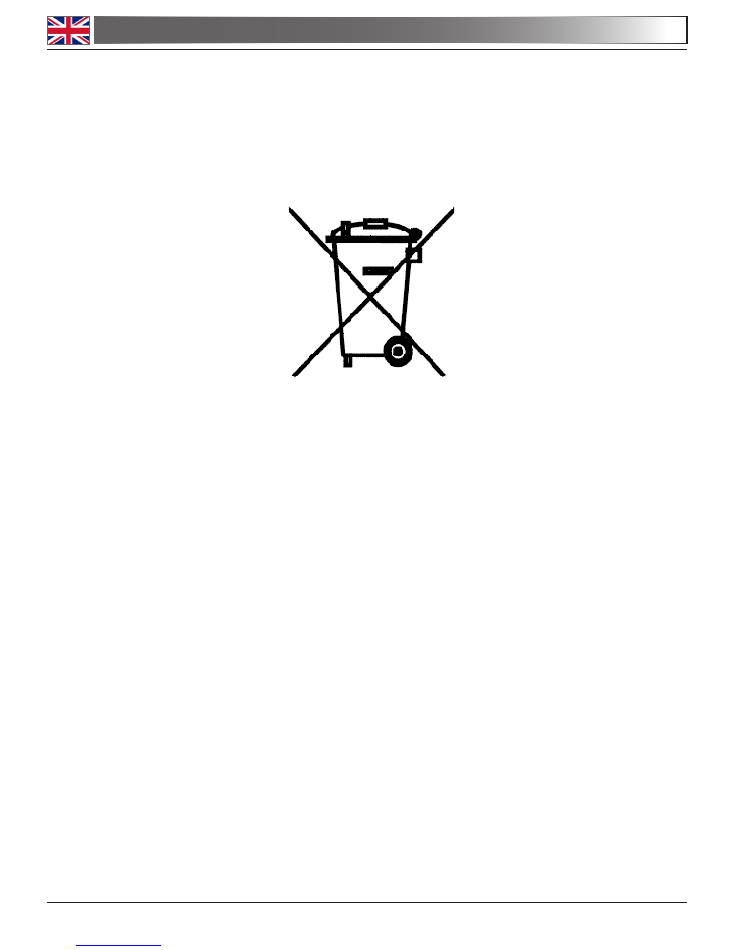
Page 14
7.0 RECOVERY AND RECYCLING
Art.13 Dlsg 25 july 2005 N°151. “According to directives 2002/95/EC, 2002/96/EC and 2003/108/EC
relating to the reduction in the use of hazardous substances in electrical and electronic equipment
and waste disposal.”
The basket symbol on equipment or on its box indicates that the product at the end of its useful life
should be collected separately from other waste.
The separate collection of this equipment at the end of its lifetime is organized and managed by
the producer. The user will have to contact the manufacturer and follow the rules that he adopted
for end-of-life equipment collection. The collection of the equipment for recycling, treatment and en-
vironmentally compatible disposal, helps to prevent possible adverse effects on the environment
and health and promotes reuse and/or recycling of materials of the equipment. Improper disposal
of the product involves the application of administrative penalties as provided by the laws in force.
